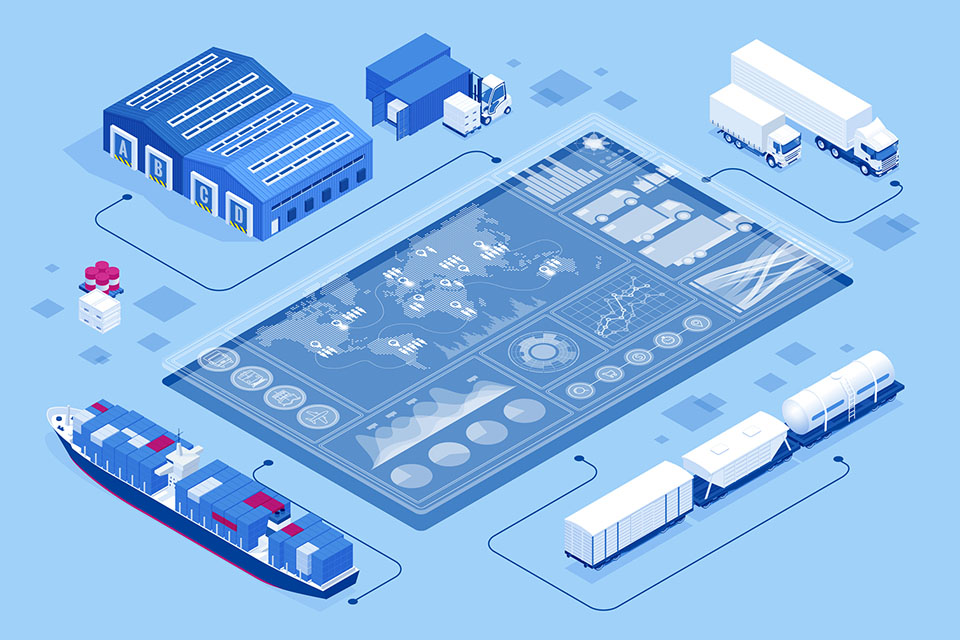Posted On July 5, 2023
Are shipping costs eating into your business’ profits?
Depending on the industry, many companies spend between 10-15% of total revenue on shipping and logistics. Decreasing that figure by even a fraction of a percent can have a big impact on your bottom line. With the right strategies and practices, you can navigate the world of logistics and reduce expenses, regardless of the mode of transportation you choose.
Optimizing your shipping operations starts by understanding the factors that affect shipping costs. So, fasten your seat belt and prepare for a journey toward streamlined shipping and enhanced profitability.
The factors affecting your shipping costs
To optimize shipping costs, you have to understand what influences them. Analyzing these variables can help you make better decisions and ultimately save money.
Distance and destination
The first factor is probably obvious. The distance between the origin and destination determines a lot of the shipping costs. As expected, longer distances result in higher shipping expenses. International shipping often incurs additional fees, such as customs, duties and taxes.
For example, shipping a package from New York to Los Angeles within the United States will likely be cheaper than sending the same package from New York to Paris, France. By considering the distance and shipping destination, you can explore alternative shipping methods that offer cost savings. This is also why businesses invest in warehousing; by storing inventory in strategic locations near customers, they can decrease shipping costs thanks to shorter distances between origin and destination.
Weight and dimensions of the package
Of course, a package’s weight plays a big role in shipping costs. What many shippers and supply chain managers don’t always realize is the impact dimensions have on cost.
Carriers typically charge based on the highest value between actual and dimensional weights (DIM weight). DIM weight is calculated by multiplying the package’s length, width and height and then dividing by a dimensional factor.
To lower shipping costs, optimize packaging by rightsizing packages to avoid oversized boxes and excessive packaging materials. Carefully consider the dimensions and weight of each package, ensuring it’s adequately protected while reducing unnecessary bulk.
For instance, if you’re shipping clothing items, a bubble mailer might be more appropriate than a box—it protects the contents without adding unnecessary weight or volume.
Mode of transportation: planes, trains or automobiles
The transportation mode you choose will also impact shipping costs. Different methods have varying cost structures, transit times and service levels. Let’s explore the advantages and considerations of each mode:
Planes: Air shipping is typically the fastest option, making it ideal for time-sensitive shipments. However, it’s generally the most expensive mode. It’s best suited for small, high-value, lightweight packages like electronics or perishable goods.
Trains: Rail transportation offers a balance between cost and speed. It’s an excellent option for long-distance domestic shipping and incredibly bulky or heavy items. Rail transport can be cost-effective when shipping large volumes or when there’s no urgency for quick delivery.
Automobiles: Road transportation is often the most flexible and accessible mode, especially for local or regional deliveries. It’s suitable for many shipments, including small packages, palletized goods and large equipment. It might take longer than air or rail, though.
By understanding the strengths and limitations of each mode, you can select the most cost-effective option for your specific shipping needs.
Additional services and requirements
Base rates are one thing. Accessorial fees, or fees handed down for additional services and requirements, can drastically change the price of shipping. These may include insurance, delivery confirmation, detention charges (where a driver has to wait longer for loading or unloading), hazmat charges, reweigh charges, signature requirements or special handling instructions. While these services offer valuable benefits, they can add to your overall expenses.
Consider your specific needs and evaluate whether these additional services are necessary for every shipment. For instance, insurance may be crucial for valuable or fragile items, while signature requirements may be unnecessary for less valuable packages.
Stay in the know without spending hours reading. Subscribe to our 2 Minutes Flat newsletter.
Researching shipping carriers and providers
Once you have a solid understanding of the factors affecting shipping costs, the next step is to research and compare carriers. This will help you identify the most cost-effective shipping options without compromising reliability and service quality.
Comparing carriers
Start by looking at carriers to understand their rates, services and coverage areas. Consider both national and regional carriers, as they may offer competitive pricing for specific routes or types of shipment. Some well-known carriers include UPS, FedEx, DHL and USPS, but countless other options are available.
Evaluate factors such as transit times, shipping zones, tracking capabilities, customer service and additional service offerings. Look for carriers that align with your shipping requirements and provide competitive rates.
Evaluating rates, services and reliability
When evaluating carriers, it’s important to look beyond just the price. Consider the overall value you’re receiving, taking into account factors like reliability. A slightly higher rate might be worth it if it guarantees faster delivery times or better customer support.
Additionally, investigate carriers’ reliability and performance by examining customer reviews, testimonials and industry reports. This research will help you make informed decisions and choose carriers that consistently meet their commitments.
Utilizing online tools for a cost comparison
You can breathe a sigh of relief—while comparing carriers and modes is recommended, we’re not suggesting you spend hours pulling up individual carrier websites, inputting shipment data and filling out sizable spreadsheets to find the best option.
There’s a much faster (and easier) way.
Using shipping cost comparison tools and transportation management systems like Flat World’s Pipeline, makes it easy to compare carriers and find the best rates. These tools allow you to input your shipment details and instantly compare rates from multiple carriers side-by-side. They can save you significant time and effort by streamlining rate comparisons.
Negotiating discounts and volume pricing
Once you’ve identified potential shipping partners, don’t hesitate to negotiate discounts and volume pricing. Many carriers offer flexible pricing structures based on your shipment volume and commitment. If you work with a third-party logistics (3PL) partner, you can often get access to rates that have been negotiated on your behalf, making this step even easier.
And knowing your shipping volumes and commitment levels can help you approach carriers. By demonstrating your potential value as a customer, you may be able to secure discounted rates or tailored pricing structures.
Optimizing your packaging and consolidating shipments
Packaging material plays a crucial role in both protecting your products and minimizing shipping costs. By optimizing your packaging and consolidating shipments, you can reduce individual costs.
Rightsizing packages to reduce dimensional weight
As mentioned, rightsizing packaging (or ensuring the packaging you’re using is the best size for the contents inside) is essential for minimizing dimensional weight. DIM weight can significantly impact shipping costs, especially if you regularly ship large, lightweight items. Avoid using excessively large boxes or unnecessary packaging materials that add bulk.
Consider using packaging calculators or working with packaging experts to ensure your packages are appropriately sized to minimize DIM weight. This optimization can lead to substantial cost savings over time.
Efficiently using packaging materials
Ensuring your items arrive safely is vital for customer satisfaction and minimizing returns or damages. But minimizing costs means finding the right balance.
Explore lightweight yet durable packaging materials that provide adequate protection. Padded envelopes can be an efficient choice for shipping small, non-fragile items. Use cushioning materials like bubble wrap or packing peanuts to safeguard delicate goods.
Evaluate the fragility and value of your products and choose appropriate packaging materials accordingly. Sometimes investing in slightly more expensive protective packaging can save you money in the long run by reducing the risk of product damage during transit.

Consolidating shipments to reduce individual costs
When possible, consolidate shipments by combining multiple packages into one. Doing so reduces the number of individual shipments, resulting in lower shipping costs.
Consider implementing a shipping strategy that allows you to consolidate orders from the same region or for the same customer. This approach, called zone-skipping, can help optimize transportation, reduce overall shipping expenses and enhance customer satisfaction.
Using technology and automation in your shipping process
It’s easy to streamline processes, improve efficiency and save money with technology. Consider adopting the following tools and techniques to optimize your shipping operations:
Implementing shipping management software
Transportation management software (or TMS) can simplify and automate your shipping in many ways. These tools typically offer features such as order management, label printing, carrier integrations and tracking capabilities.
Centralizing your shipping operations on one platform saves time, reduces errors and efficiently manages your shipments. Even for TMS platforms that require an investment, the benefits and returns can significantly outweigh any costs.
Automating shipping processes
Automation can significantly improve efficiency and reduce human error in shipping operations. Look for opportunities to automate repetitive tasks like shipping label printing, order fulfillment and tracking notifications.
Integrate your shipping systems with your e-commerce platform or order management system to streamline workflows. Automation not only saves time but reduces the risk of mistakes that can lead to additional costs.
Leveraging data analytics to identify cost-saving opportunities
Utilize data analytics to gain insights into your shipping operations and identify potential cost-saving opportunities. Analyze shipping data such as carrier performance, shipping volume and transit times to pinpoint areas for improvement.
Identify carriers or routes that consistently offer competitive rates and reliable service—and vice versa: look for any patterns of damage, late deliveries and other issues that could be causing harm to your customer service and bottom line. Leverage this information to negotiate better pricing or make informed decisions about which carriers to use for specific shipments.
Integrating shipping systems with e-commerce platforms
If you operate an e-commerce business, integrating your shipping systems with your online store can streamline your fulfillment processes. This integration allows automatic order syncing, real-time shipping rates and tracking updates.
By eliminating manual data entry and providing accurate shipping information to your customers, you enhance the overall customer experience while minimizing the risk of shipping-related issues and additional costs.
Exploring alternative shipping methods
While sticking with a single mode of transportation is the most common way to ship, exploring alternative methods can provide additional cost-saving opportunities.
The benefits of air, rail and road transportation
Specialized or niche services can offer cost advantages, for example:
- Intermodal transportation combines multiple modes of transport, such as rail and road, to optimize cost and efficiency. It’s particularly beneficial for long-distance shipping or when a particular mode better serves specific segments of the journey.
- Less-than-truckload (LTL) shipping involves consolidating multiple smaller shipments into a single truckload. This method is cost-effective for smaller volumes and can provide savings compared to full truckload (FTL) shipping.
- Last-mile delivery partnerships with local carriers or third-party providers can be more cost-effective than relying solely on large, national and international carriers.
Choosing the most cost-effective mode for different types of shipments
Not all shipments require the same transportation mode. Assess your shipping needs and consider the best shipping method for specific products or destinations.
For example, if you’re shipping bulky items within a specific region, road transportation may be more cost-effective than air or rail, but the same items going to a different region might be better sent via rail. Evaluate each shipment’s size, weight and urgency to determine the most suitable mode for each case.
Collaborating with freight forwarders or third-party logistics providers
Freight forwarders and third-party logistics (3PL) providers can offer specialized services and cost-saving opportunities because these organizations have established relationships with carriers and can negotiate favorable rates on your behalf.
Partnering with a freight forwarder or 3PL provider allows you to leverage their expertise, technology, industry connections and consolidated volumes. This collaboration can result in reduced shipping costs and improved logistics management.
Don’t miss out on the latest logistics news. Subscribe to 2 Minutes Flat today.
Negotiating and leveraging carrier relationships
Developing long-term relationships with shipping companies can be mutually beneficial and help you secure more favorable rates. Consider the following strategies for negotiating and leveraging your relationships.
Building long-term relationships
Consistency and loyalty are valuable in the shipping industry. Building long-term relationships with carriers and providers can open doors to negotiated rates.
Maintain open lines of communication with your carriers and express your commitment to a long-term partnership. Regularly review your shipping volumes and performance with them to demonstrate your value as a customer.
Negotiating contracts and rates
You gain leverage to negotiate better contracts and rates as your shipping volumes increase. Reach out to your carriers and discuss your shipping projections. Highlight the potential business growth you anticipate and how it benefits the carrier as well. Negotiate favorable terms based on your volume, commitment and projected value to the carrier.
Tapping into loyalty programs and partnerships
Many shipping carriers offer loyalty programs or partnerships that provide additional benefits to frequent shippers. These programs can include discounted rates, priority service or specialized support.
Research carriers’ loyalty programs and determine if they align with your shipping needs. By taking advantage of these programs, you can access exclusive shipping discounts and benefits and further reduce your costs.
Tracking and monitoring your shipments
Monitoring and tracking your shipments throughout the shipping process ensures visibility, allows you to resolve problems quickly and prevents additional costs.
Keeping track of your shipments
It’s crucial to prioritize supply chain visibility to meet the demand for real-time information. Selecting carriers that offer robust tracking capabilities allows you and your customers to monitor shipment progress from pick-up to delivery. Visibility enables you to proactively address delays or issues during transit. It also helps manage customer expectations and reduces inquiries or complaints.
Utilizing tracking technologies and software
Just like finding the best carrier rates is faster and easier with technology, so are visibility and tracking. Leverage tracking technologies and software to streamline your tracking process. These tools can provide real-time updates, automate tracking notifications for customers and consolidate tracking information from multiple carriers into a single platform.
Invest in shipping software that integrates with all major carriers and provides comprehensive tracking features. This ensures you have a centralized view of all your shipments, regardless of the carrier used.

Addressing issues promptly to avoid additional shipping fees
When tracking your shipment, make sure to resolve any issues or exceptions that arise. This may include delays, lost packages or damages. Communicate directly with the carrier and work together to resolve the issue. Timely intervention can prevent additional costs associated with re-shipments, returns or customer dissatisfaction.
Evaluating carrier performance
Regularly evaluate carrier performance to ensure they meet your expectations and deliver on their commitments. Monitor on-time delivery rates, damaged goods percentages and customer satisfaction ratings.
If a carrier consistently falls short in performance or reliability, consider switching to an alternative carrier. Continuously assessing carrier performance allows you to make informed decisions and maintain the highest level of service while optimizing costs.
Enlisting outside help to reduce shipping costs
Minimizing shipping costs takes knowledge, research and strategic decision-making. These elements can help you navigate the shipping landscape and find savings opportunities.
There’s a delicate balance to your shipping. Trying to reduce costs shouldn’t compromise your shipping operation. Armed with the right knowledge and tools, you can confidently embark on your shipping optimization journey, saving valuable time and money along the way.
But if you want to maximize your results and accelerate your progress, you don’t have to tackle it alone. Flat World Global Solutions has helped businesses improve their shipping costs and operations for decades with industry-leading technology and expert insights. Contact us to discover how our tailored solutions align with your business needs.

